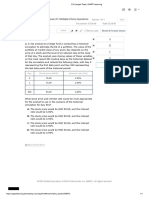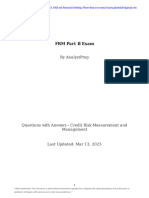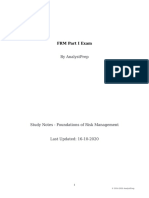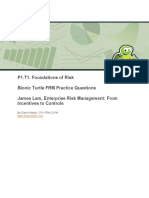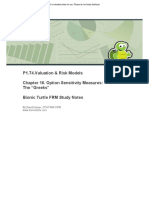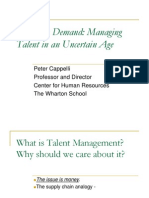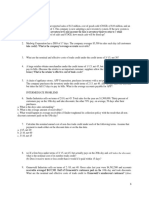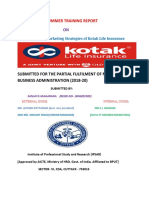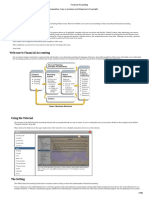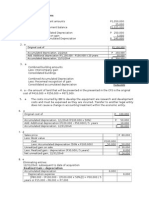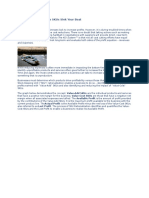FRM Part II Formulas
all FRM part II formulas
The FRM (Financial Risk Manager) Part II exam is comprehensive and includes a wide range of
formulas related to risk management. Below are some of the key formulas you should know for FRM
Part II, divided by relevant topics:
1. Market Risk
Value at Risk (VaR):
VaR = Z × σ × T
Where:
Z = Z-score corresponding to confidence level (e.g., 1.65 for 95% confidence)
σ = standard deviation of returns
T = holding period (in years, typically)
Expected Shortfall (ES) or Conditional VaR (CVaR):
1
1
ES = ∫ VaRα dα
1−α α
This is the average loss in the tail beyond the VaR threshold.
Portfolio VaR (using covariance matrix):
VaRportfolio = wT Σw
Where:
w = vector of portfolio weights
Σ = covariance matrix of asset returns
2. Credit Risk
Credit Valuation Adjustment (CVA):
CVA = (1 − Recovery Rate) × Exposure at Default × Probability of Default
Exposure at Default (EAD): The measure of the potential loss in the event of a default.
Credit Spread:
Credit Spread = Yield on Risky Bond − Yield on Risk-Free Bond
3. Operational Risk
1/4
� Loss Distribution: Operational risk is typically modeled by a loss distribution, where:
L = Loss Amount
F (L) = Cumulative Distribution Function (CDF)
μ = mean loss
σ = standard deviation
Risk Control Self-Assessment (RCSA): This involves rating the likelihood and impact of operational
risks.
4. Liquidity Risk
Liquidity Coverage Ratio (LCR):
High-Quality Liquid Assets
LCR = ≥ 100%
Total Net Cash Flows over 30 Days
Net Stable Funding Ratio (NSFR):
Available Stable Funding
NSFR = ≥ 100%
Required Stable Funding
5. Interest Rate Risk
Duration (Macaulay Duration):
T
∑ t × PV of Cash Flowt
D = t=1
Price of Bond
Modified Duration:
D
Dmod =
1 + ny
Where:
y = Yield to maturity
n = Number of periods per year
Convexity:
T
∑ t(t + 1) × PV of Cash Flowt
C = t=1
Price of Bond
Duration Gap:
Market Value of Liabilities
Duration Gap = Duration of Assets − ( ) × Duration of Liabilities
Market Value of Assets
6. Risk Management and Measurement
2/4
� Sharpe Ratio:
Rp − Rf
S=
σp
Where:
Rp = Portfolio return
Rf = Risk-free rate
σp = Standard deviation of portfolio returns
Jensen's Alpha:
α = Rp − [Rf + β(Rm − Rf )]
Where:
β = Beta of the portfolio
Rm = Return on the market
7. Capital Asset Pricing Model (CAPM)
CAPM:
Ri = Rf + β(Rm − Rf )
Where:
Ri = Expected return on asset i
β = Beta of asset i
Rm = Expected market return
Rf = Risk-free rate
8. Regression and Time Series Models
Linear Regression:
Y = α + βX + ϵ
Where:
Y = Dependent variable
X = Independent variable
α = Intercept
β = Slope
ϵ = Error term
3/4
� Autoregressive (AR) Model:
p
Yt = α + ∑ βi Yt−i + ϵt
i=1
Where:
Yt = Time series value at time t
p = Order of autoregression
ϵt = Error term
These are just some of the major formulas you should be familiar with for FRM Part II. It's a good idea
to practice solving problems involving these formulas and understanding the contexts in which they
are applied.
4/4






